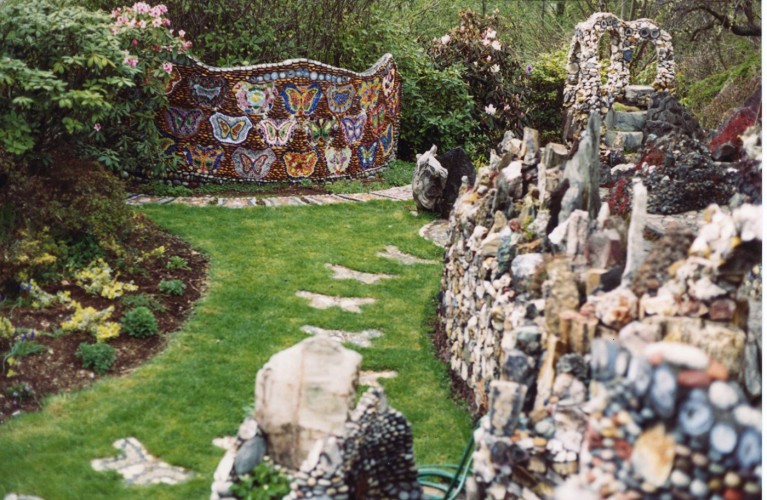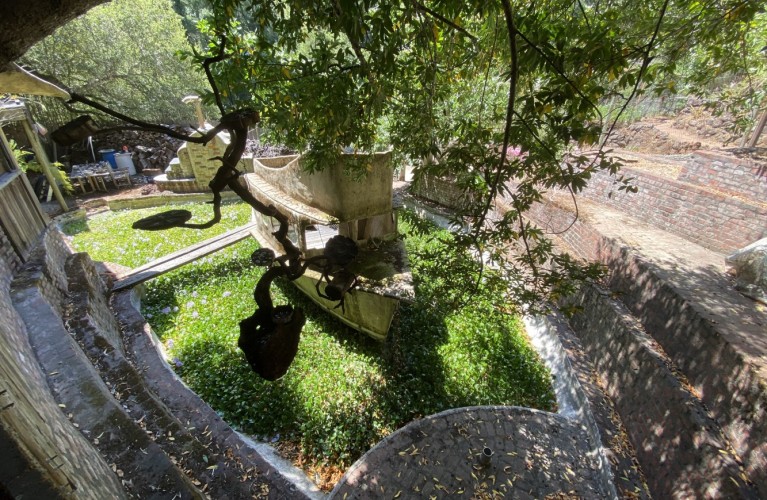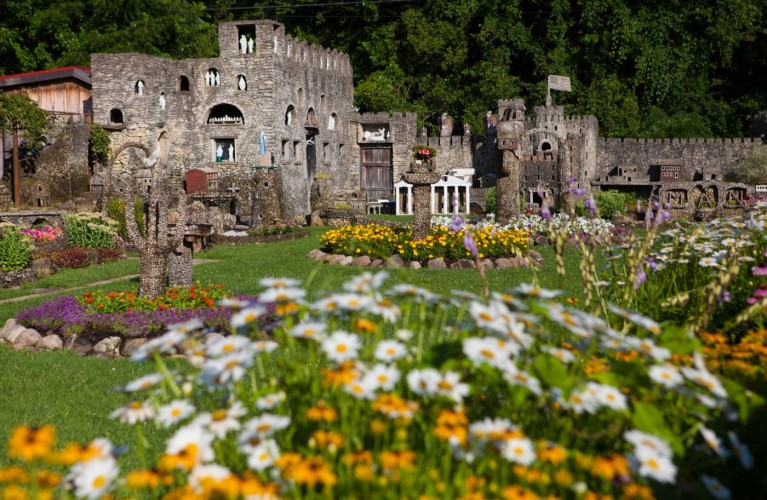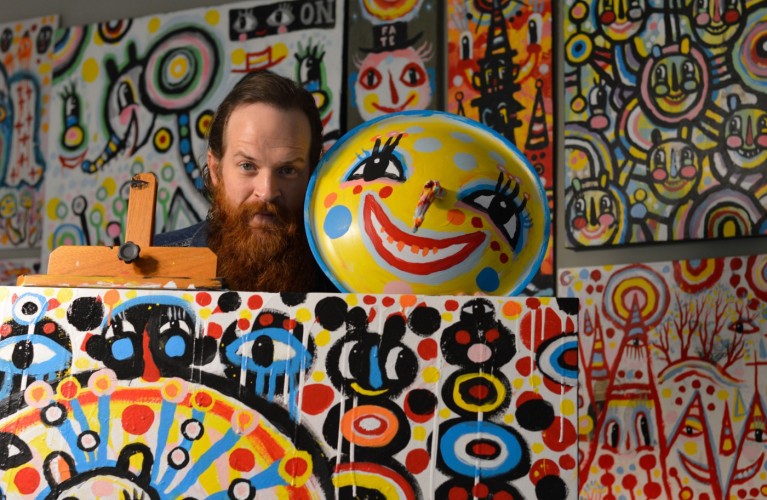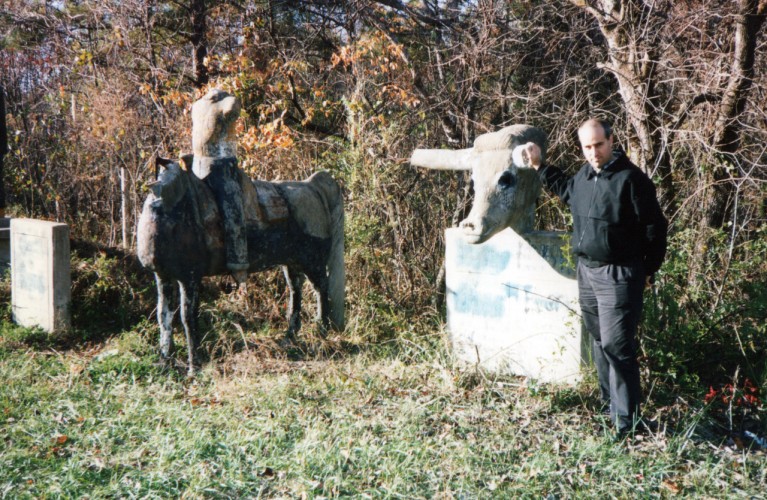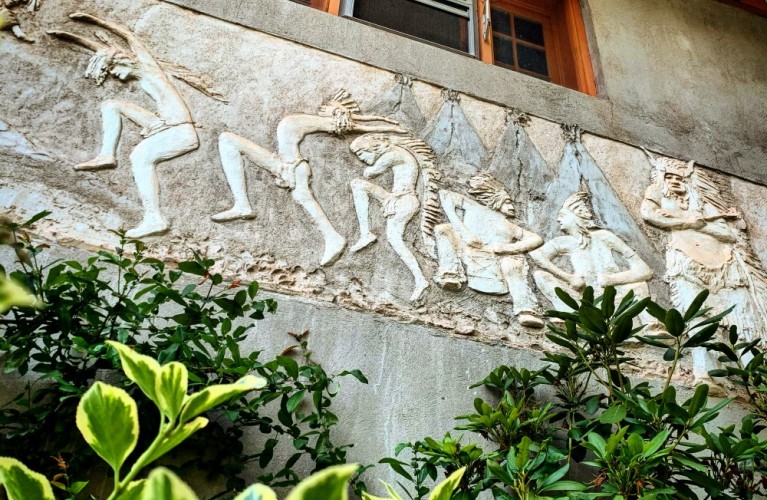Blog
In Memory of the Walker Rock Garden
For many years, Milton and Florence Walker created a sprawling, terraced rock garden in the yard of their home on a hill in West Seattle.The site included intricately mosaicked rock walls, pathways, towers, and other structures weaving back and forth across the undulating property. After the Walkers passed away, several groups and individuals fought to purchase and protect the residential site, but it remained in the possession of family members until it was razed in early June 2021.
Final Effort to Save The Last Resort
After years of uncertainty regarding the future of David Lee Hoffman’s The Last Resort in Lagunitas, California, it appears that a recent court decision will result in the site being razed.
A Pilgrimage to the Shrine and Grottos of the Black Madonna
SPACES is happy to share this guest post from Gabrielle Christiansen on her recent visit to a grotto environment outside of St. Louis, Missouri. Christiansen is a Midwest-based art historian and museum worker who graduated from the Modern and Contemporary Art History Master's program at the School of the Art Institute of Chicago in 2020.
The Hartman Rock Garden: Past, Present, and Future with Kevin Rose
In 1932, during the height of the Great Depression, Harry George “Ben” Hartman (1883-1944) began building a rock garden after losing his job as an iron molder. He started small with the creation of a fishing pond, and over the next decade – with time, cement, and thousands and thousands of rocks – Hartman filled his yard in Springfield, Ohio with over fifty fascinating stone and concrete sculptures, diverse plants, and handcrafted figurines. Kevin Rose, curator at the Hartman Rock Garden, took some time to answer questions about his experience with this midwestern art environment, its connection to his community, and what's next for the rock garden.
A Conversation with Kyle BlackCatTips Brooks
SPACES Archives recently reached out to Kyle BlackCatTips Brooks, an artist living and working near Atlanta, Georgia, to learn more about his practice and his developing art environment. He took our interview questions and transformed them into an incredible short film, featuring himself and a character he created—The Green Hand—voiced by actor Marcus Hopkins-Turner.
Interview with Gregg Blasdel: Artist, Curator, Educator
Gregg Blasdel is an artist, curator, and educator. His seminal Art in America article “The Grass Roots Artist” introduced a broad arts audience to artist-built environments in 1968. His curatorial work includes Naives and Visionaries at the Walker Art Center in Minneapolis in 1974, and his photography has been featured in numerous publications, including Fantastic Architecture and Eccentric Visions (1980) and Jesse Howard and Roger Brown; Now Read On (2006).
Interview with Bill Swislow: SPACES Board Emeritus
William Swislow, a founder and longtime executive at Cars.com, is now a digital media consultant, writer, art collector, and a lecturer at Northwestern’s Medill School of Journalism. He sits on the boards of Intuit: The Center for Intuitive and Outsider Art and the Daily Cardinal Alumni Association. Swislow has written about art for a variety of publications, including The Chicago Tribune, RAW VISION, and Intuit’s Outsider Magazine. He has curated exhibits focused on art made from bottle caps, metal worker Stanley Szwarc, and most recently, on work by lesser-known and anonymous artists from Chicago.
Embedding the Surface: Concrete Art Environments and D.I.Y. Rubblework
From the Hartman Rock Garden of Springfield, Ohio, to the Christensen Rock Garden of Albert Lea, Minnesota, nearly every concrete sculpture garden in the Midwest includes some form of mosaic rubblework. Fred Smith (1886-1976) of the Wisconsin Concrete Park used broken bottles to decorate his concrete sculptures because he liked the way the color and reflectiveness of the glass colored the otherwise “dead” concrete. Even the Rudolph Grotto Garden and Wonder Cave, where Father Philip Wagner (1882–1959) intentionally hid his cement structures beneath the rocks for a natural appearance, features surface ornamentation using glass from the Kokomo Opalescent Glass Company (Kokomo, Indiana). So, where did they get their ideas? Though each artist had access to different materials, leading to their own signature style, the overall aesthetics are remarkably similar.
Mullinville's M.T. Liggett Visitors Center Nears Opening
Myron Thomas (M.T.) Liggett (1930–2017) was well known for creating metal totems and whirligigs and has been called a folk artist, provocateur, activist, a “poker”, and more. With the upcoming opening of a new visitors center in his name, his expressive artworks–and the sometimes heated conversations they inspired–will continue on.M.T. Ligget in his workshop. Photo: Arden Bradshaw
Getting on the Map: Completing a National Register of Historic Places Nomination
7 Steps Toward Completing a Successful National Register of Historic Places NominationEmma Mooney is an art and architectural historian currently pursuing a Master of Preservation Studies degree at Tulane University. She first realized her interest in the built environment during an internship with the John Michael Kohler Arts Center in 2014 and since then has researched art environments such as Joe Minter’s African Village in America and Clementine Hunter’s African House Murals. Before becoming involved in historic preservation, she worked in museum collections management, most recently at the Cooper Hewitt, Smithsonian Design Museum and the American Folk Art Museum.
The Mary Nohl Art Environment is on the National Register of Historic Places. See the full nomination through the NRHP.
